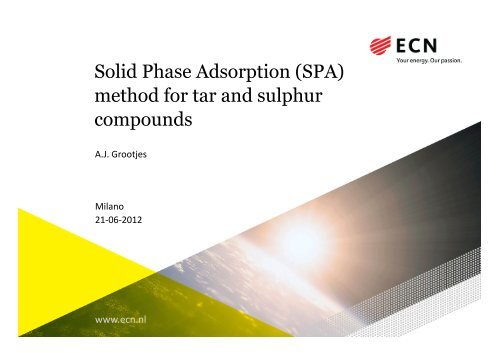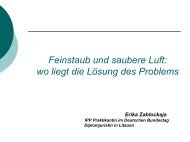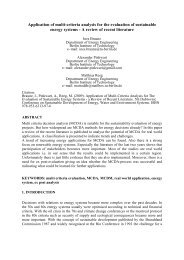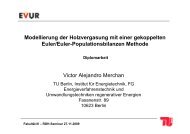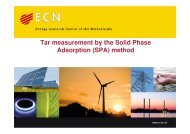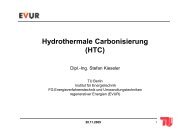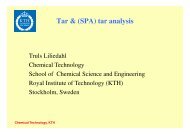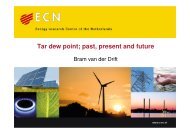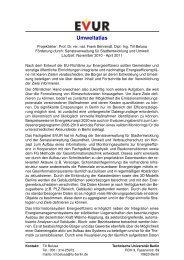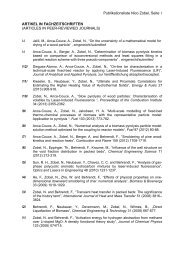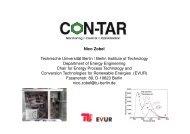(SPA) method for tar. Analysis of heavy tars. - BRISK
(SPA) method for tar. Analysis of heavy tars. - BRISK
(SPA) method for tar. Analysis of heavy tars. - BRISK
Create successful ePaper yourself
Turn your PDF publications into a flip-book with our unique Google optimized e-Paper software.
Solid Phase Adsorption (<strong>SPA</strong>)<br />
<strong>method</strong> <strong>for</strong> <strong>tar</strong> and sulphur<br />
compounds<br />
A.J. Grootjes<br />
Milano<br />
21-06-2012<br />
www.ecn.nl
Introduction<br />
• Our desire: measurement <strong>of</strong> biomass <strong>tar</strong>s after gasifier/gas clean-up,<br />
easy to use, low cost up to analysis<br />
• Guideline <strong>method</strong> too cumbersome, only used by gasification
<strong>SPA</strong> <strong>method</strong> <strong>for</strong> <strong>tar</strong>s: sampling<br />
• 100 ml gas at constant flow rate (50 ml/min) by automated syringe pump<br />
• Type <strong>of</strong> <strong>SPA</strong>: LC-NH2 (aminopropyl), 100mg<br />
• Volatile compounds (BTEX) are not 100% adsorbed (pass through<br />
adsorbent, we use micro-GC <strong>for</strong> Benzene & Toluene)<br />
• All other measured compounds (oxygenated compounds , N PAHs & PAHs<br />
without hetero atoms) adsorb & desorb well<br />
• Heavy compounds (MW>300) do not evaporate sufficiently in a GC-FID<br />
and are not measured<br />
3
<strong>SPA</strong> <strong>method</strong> <strong>for</strong> <strong>tar</strong>s: analysis<br />
• 33 compounds identified, other peaks labelled as ‘Unknowns’ &<br />
classified in 5 groups according to elution on the GC column<br />
• Tar clasification system by ECN:<br />
Class 1<br />
Class 2<br />
Class 3<br />
Class 4<br />
Class 5<br />
GC undetectable <strong>tar</strong>s. This class includes the heaviest <strong>tar</strong>s that condense at high temperature<br />
even at very low concentrations.<br />
Heterocyclic components (like phenol, pyridine, cresol). These are components that generally<br />
exhibit high water solubility, due to their polarity.<br />
Aromatic components. Light hydrocarbons that are not important in condensation and water<br />
solubility issues.<br />
Light polyaromatic hydrocarbons (2-3 rings PAH’s). These components condense at relatively<br />
high concentrations and intermediate temperatures.<br />
Heavy polyaromatic hydrocarbons (4-5 rings PAH’s). These components condense at relatively<br />
high temperature at low concentrations.<br />
4
Experiments with tandem <strong>SPA</strong><br />
column: <strong>tar</strong>s<br />
• <strong>SPA</strong> sampling <strong>of</strong> hot gas leads to warming <strong>of</strong> <strong>SPA</strong> column<br />
• Experiment with two <strong>SPA</strong>s in series, 1 st results (ratio component in <strong>SPA</strong>s) :<br />
Benzene Toluene Ethyl -<br />
Benzene<br />
m/p -<br />
Xylene<br />
O-Xylene<br />
+ Styrene<br />
Phenol Naphtalene<br />
1 st <strong>SPA</strong> 16% 14% 16% 26% 28% 100% 100%<br />
2 nd <strong>SPA</strong> 84% 86% 84% 74% 72% 0% 0%<br />
• Light compounds (< phenol) adsorb more in 2nd column<br />
• Benzene & toluene not completely adsorbed after 2 <strong>SPA</strong>s: according to<br />
µGC only 20% and 66% <strong>of</strong> amount in gas adsorbed<br />
• <strong>SPA</strong> <strong>method</strong> not perfect <strong>for</strong> measurement <strong>of</strong> light <strong>tar</strong>s from hot gas<br />
5
Conclusion tandem <strong>SPA</strong>s: <strong>tar</strong>s<br />
• BTEX not well adsorbed on 1 st <strong>SPA</strong><br />
• 1 st <strong>SPA</strong> warms up when sampling from hot gas<br />
• Boiling point (±80 - 140 °C) & polarity influence adsorption on LC-NH2<br />
column<br />
• Tandem <strong>SPA</strong>s improve capture <strong>of</strong> lighter compounds<br />
• LC-NH2 is high polar, perhaps medium polar columns work better<br />
• Controlling the temperature <strong>of</strong> the column during sampling may improve<br />
adsorption<br />
• So far, ECN is satisfied with the <strong>SPA</strong> <strong>method</strong>, but there is room <strong>for</strong><br />
improvement or adaptation to other compounds than <strong>tar</strong>s<br />
6
‘Heavy’ <strong>tar</strong> measurements:<br />
first results
‘Heavy <strong>tar</strong>s matter most’<br />
Fluoranthene<br />
(202 g/mol)<br />
Benzo(a)pyrene<br />
(252 g/mol)<br />
• 50 g/mol heavier <strong>tar</strong>s dominate <strong>tar</strong> dew point, even at 1/10 th the<br />
concentration<br />
• Fouling by <strong>tar</strong> occurs at surfaces with temperature <strong>of</strong> 300 and even<br />
above 400°C<br />
• ´Coronene is not the problem´<br />
• <strong>SPA</strong> does not quantify the <strong>tar</strong>s that matter<br />
Coronene<br />
(300 g/mol)<br />
Dew Point<br />
(calculated)<br />
- - 100 mg/Nm 3 236°C<br />
- 1 000 mg/Nm 3 100 mg/Nm 3 237°C<br />
10 000 mg/Nm 3 1 000 mg/Nm 3 100 mg/Nm 3 239°C<br />
8
‘Heavy’ <strong>tar</strong> measurement<br />
• GC-FID <strong>tar</strong> analysis limited to coronene (MW300)<br />
• Quantify ‘<strong>heavy</strong>’ <strong>tar</strong>s by measurement with micr<strong>of</strong>iber extraction<br />
(Soxhlet) thimbles<br />
• Tar condensation at thimble temperature <strong>of</strong> 350, 450, 550 °C<br />
• Extraction with DCM<br />
• Sample point after MILENA gasifier<br />
9
‘Heavy’ <strong>tar</strong> measurement<br />
• 1 st and 2nd experiment: extracts with DCM<br />
• GC-FID indicate majority Coronene and peaks beyond Coronene<br />
• Tar and dust collected in the same thimble<br />
• Conclusion: probably not all <strong>tar</strong>s are extracted with DCM or are<br />
irreversibly condensed on dust or filter material<br />
• 3 rd experiment: 1 st thimble @ 550 °C (dust filter),<br />
2 nd @ 350 °C (<strong>tar</strong> condensation), extraction with<br />
DCM and NMP<br />
• HT GC-FID <strong>method</strong> under development to analyse<br />
<strong>tar</strong>s MW>300<br />
• Extracts send to JRC <strong>for</strong> SEC (Size Exclusion<br />
Chromatography)<br />
10
Final remarks<br />
• ECN can analyse <strong>SPA</strong> samples <strong>for</strong> 3 rd parties<br />
• Perhaps implementing improvements <strong>of</strong> the <strong>SPA</strong> <strong>method</strong>, developed by<br />
different groups, into one document, resulting in a united improved <strong>SPA</strong><br />
<strong>method</strong>?<br />
11
Thank you <strong>for</strong> your attention!<br />
Questions?
Acknowledgement<br />
Part <strong>of</strong> the work was funded by the EDGaR program and the <strong>BRISK</strong> project:<br />
The research program EDGaR acknowledges the contribution <strong>of</strong> the funding agencies:<br />
The Northern Netherlands Provinces (SNN). This project is co-financed by the<br />
European Union, European Fund <strong>for</strong> Regional Development and the Ministry <strong>of</strong><br />
Economic Affairs, Agriculture and Innovation. Also the Province <strong>of</strong> Groningen is c<strong>of</strong>inancing<br />
the project.<br />
<strong>BRISK</strong> is funded by the European<br />
Commission Seventh Framework<br />
Programme (Capacities)<br />
ECN<br />
Westerduinweg 3 P.O. Box 1<br />
1755 LE Petten 1755 ZG Petten<br />
The Netherlands The Netherlands<br />
T +31 224 56 49 49 info@ecn.nl<br />
F +31 224 56 44 80 www.ecn.nl<br />
13
<strong>SPA</strong> measurement <strong>for</strong><br />
sulphur compounds: first<br />
results
Experiments with tandem <strong>SPA</strong><br />
column: sulphur compounds<br />
• Heavy (Di)methyl DBTs below detection limit<br />
• Experiment with two <strong>SPA</strong>s in series, 1 st results:<br />
Thiophene 2-Methyl<br />
thiophene<br />
3-Methyl<br />
thiophene<br />
1-benzo<br />
thiophene<br />
Dibenzo<br />
thiophene<br />
1 st <strong>SPA</strong> 14% 95%<br />
2 nd <strong>SPA</strong> 86% >65% >75%
Conclusion tandem <strong>SPA</strong>s: <strong>tar</strong>s<br />
and S-compounds<br />
• 1-ring S compounds not well adsorbed on 1 st <strong>SPA</strong><br />
• 1 st <strong>SPA</strong> warms up when sampling from hot gas<br />
• Boiling point (±80 - 140 °C) & polarity influence adsorption on LC-NH2<br />
column<br />
• Tandem <strong>SPA</strong>s improve capture <strong>of</strong> lighter compounds<br />
• LC-NH2 is high polar, perhaps medium polar columns work better<br />
• Controlling the temperature <strong>of</strong> the column during sampling may improve<br />
adsorption<br />
16
Final remarks<br />
• ECN can analyse <strong>SPA</strong> samples <strong>for</strong> 3 rd parties<br />
• Perhaps implementing improvements <strong>of</strong> the <strong>SPA</strong> <strong>method</strong>, developed by<br />
different groups, into one document, resulting in a united improved <strong>SPA</strong><br />
<strong>method</strong>?<br />
17
Thank you <strong>for</strong> your attention!<br />
Questions?
Acknowledgement<br />
Part <strong>of</strong> the work was funded by the EDGaR program and the <strong>BRISK</strong> project:<br />
The research program EDGaR acknowledges the contribution <strong>of</strong> the funding agencies:<br />
The Northern Netherlands Provinces (SNN). This project is co-financed by the<br />
European Union, European Fund <strong>for</strong> Regional Development and the Ministry <strong>of</strong><br />
Economic Affairs, Agriculture and Innovation. Also the Province <strong>of</strong> Groningen is c<strong>of</strong>inancing<br />
the project.<br />
<strong>BRISK</strong> is funded by the European<br />
Commission Seventh Framework<br />
Programme (Capacities)<br />
ECN<br />
Westerduinweg 3 P.O. Box 1<br />
1755 LE Petten 1755 ZG Petten<br />
The Netherlands The Netherlands<br />
T +31 224 56 49 49 info@ecn.nl<br />
F +31 224 56 44 80 www.ecn.nl<br />
19


